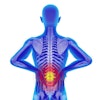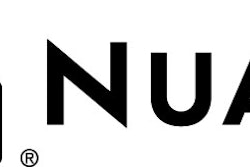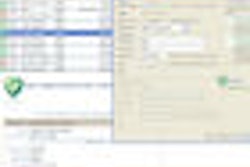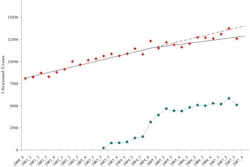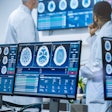CHICAGO - One of the (many) trends currently vexing medical imaging is the rise of radiology benefits management (RBM) firms. But decision-support software could be an alternative for fighting overutilization that gives physicians the tools they need to more effectively order imaging studies -- without the heavy-handed oversight that RBMs typically use.
That's according to a presentation at this week's Healthcare Information and Management Systems Society (HIMSS) annual meeting. Victor Panza from healthcare informatics firm Nuance Communications of Burlington, MA, discussed how his firm collaborated with Massachusetts General Hospital (MGH) of Boston to develop a software-based decision-support tool that helped drastically cut the growth rate of advanced imaging procedures.
Spending on medical imaging has become one of the hot button issues in the debate over runaway healthcare spending. Overall, the U.S. spends some $100 billion on medical imaging annually, with volume growing at a 20% rate. It's estimated that up to one-third of imaging procedures do not contribute to patient care, resulting in costs between $3 billion and $10 billion annually, Panza said.
RBM companies have arisen as a potential solution to the problem by creating a "gatekeeper" that payors use to oversee imaging utilization. Payors are requiring physicians in their networks to contract with RBM firms; orders for advanced imaging exams are then vetted by RBM staff according to predetermined appropriateness criteria.
It's an arrangement that no one likes, as many physicians find the process cumbersome and a possible infringement on their independence. But it is effective: A 2008 report by America's Health Insurance Plans (AHIP) of Washington, DC, estimated that the use of RBMs cut imaging expenditures by 10% to 20%, and the Medicare Payment Advisory Commission (MedPAC) has recommended that RBMs be examined for use in the Medicare system.
An IT alternative?
At MGH, the hospital was facing the same problems regarding imaging utilization as many other U.S. healthcare institutions. MGH was seeing outpatient CT and MRI studies grow at a 12% compound annual growth rate (CAGR), Panza said. But rather than implement an RBM program, MGH decided to go a different route.
Partnering with Nuance, MGH developed a set of imaging appropriateness criteria that could be implemented as a decision-support module with the hospital's existing computerized radiology order entry (ROE) system, which had been in place since 2003. MGH started with the American College of Radiology's (ACR) Appropriateness Criteria, but added its own clinical algorithms regarding the best imaging test for a particular circumstance -- ultimately expanding the number of "scores" in the system from 3,000 with the ACR's criteria to 15,000.
With the decision-support module, physicians ordering an imaging exam receive a color-coded score of 1-9 after they enter a study into the ROE system. Studies with low appropriate scores are colored red and are rated 1-3, marginal studies are coded yellow and scored 4-6, and appropriate exams are colored green and coded 7-9. For orders of low and marginal utility, alternative exams are suggested.
The decision-support tool went into operation at MGH in 2004. Imaging utilization fell almost immediately, from the 12% annual growth rate before decision support was used to 1% afterward -- a rate that has held steady for the past three years. The group estimated that low-utility CT scans declined from 11% in 2004 to 4% in 2006, and high-utility CT rose from 86% to 93%.
MGH physicians are also seeing higher rates of positive MRI and CT scans, Panza said, a sign that they are ordering clinically indicated studies. Positive findings in radiology reports have increased from 74% to 84% for CT and from 73% to 85% for MRI.
Researchers from MGH and the University of Florida Health Center in Gainesville have published findings on their use of the software in the April 2009 issue of Radiology (Vol. 251:1, pp. 1-9).
Back-end analytics
The decision-support module has more to it, however, than just what physicians see when they order an exam, Panza said. It includes a data collection and analysis component that can be used to compare the utilization trends of different physicians, and also compare these trends to patient outcomes.
"The ability to mine this data and develop data analysis to the physician and practice level is unlimited," Panza said.
Nuance began marketing a commercial version of the decision-support software, which it calls RadPort, 18 months ago, and the software is installed at 12 sites, according to Michael Mardini, vice president of diagnostic solutions at the company. The back-end analytics component of the software is called RadCube.
RadPort can be installed as a standalone Web-based application that physicians can query from a workstation. It can also be added as a front-end layer to an existing computerized physician order entry system that a facility might already have in operation.
Panza believes that the MGH experience indicates that decision-support software can accomplish the goal of limiting overutilization without alienating physicians, as is often the case with the RBM model.
"It's a more legitimate way of managing [utilization] and feeding data back to physicians," Panza said. "Physicians are generally receptive to feedback ... many times they didn't know they were ordering two or three times more MRIs than their colleagues."
By Brian Casey
AuntMinnie.com staff writer
April 7, 2009
Related Reading
Study: Electronic orders deliver more clinical detail, April 2, 2009
Decision-support software cuts imaging procedure volume, March 24, 2009
CT protocol ordering software increase efficiency, January 29, 2009
Healthcare IT saves lives, cuts costs, study finds, January 27, 2009
Copyright © 2009 AuntMinnie.com



